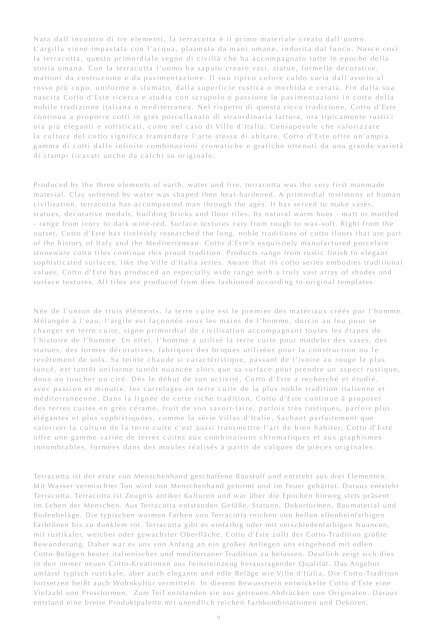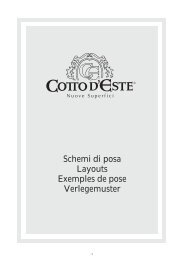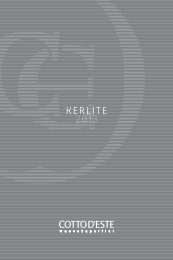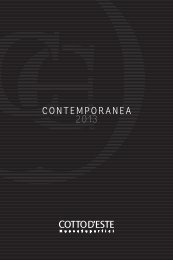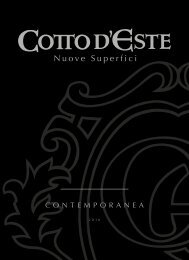catalogo classica - Cotto d'Este
catalogo classica - Cotto d'Este
catalogo classica - Cotto d'Este
You also want an ePaper? Increase the reach of your titles
YUMPU automatically turns print PDFs into web optimized ePapers that Google loves.
Nata dall’incontro di tre elementi, la terracotta è il primo materiale creato dall’uomo.<br />
L’argilla viene impastata con l’acqua, plasmata da mani umane, indurita dal fuoco. Nasce così<br />
la terracotta, questo primordiale segno di civiltà che ha accompagnato tutte le epoche della<br />
storia umana. Con la terracotta l’uomo ha saputo creare vasi, statue, formelle decorative,<br />
mattoni da costruzione e da pavimentazione. Il suo tipico colore caldo varia dall’avorio al<br />
rosso più cupo, uniforme o sfumato, dalla superficie rustica o morbida e cerata. Fin dalla sua<br />
nascita <strong>Cotto</strong> d’Este ricerca e studia con scrupolo e passione le pavimentazioni in cotto della<br />
nobile tradizione italiana e mediterranea. Nel rispetto di questa ricca tradizione, <strong>Cotto</strong> d’Este<br />
continua a proporre cotti in gres porcellanato di straordinaria fattura, ora tipicamente rustici<br />
ora più eleganti e sofisticati, come nel caso di Ville d’Italia. Consapevole che valorizzare<br />
la cultura del cotto significa tramandare l’arte stessa di abitare, <strong>Cotto</strong> d’Este offre un’ampia<br />
gamma di cotti dalle infinite combinazioni cromatiche e grafiche ottenuti da una grande varietà<br />
di stampi ricavati anche da calchi su originale.<br />
Produced by the three elements of earth, water and fire, terracotta was the very first manmade<br />
material. Clay softened by water was shaped then heat-hardened. A primordial testimony of human<br />
civilisation, terracotta has accompanied man through the ages. It has served to make vases,<br />
statues, decorative medals, building bricks and floor tiles. Its natural warm hues - matt or mottled<br />
- range from ivory to dark wine-red. Surface textures vary from rough to wax-soft. Right from the<br />
outset, <strong>Cotto</strong> d’Este has tirelessly researched the long, noble traditions of cotto floors that are part<br />
of the history of Italy and the Mediterranean. <strong>Cotto</strong> d’Este’s exquisitely manufactured porcelain<br />
stoneware cotto tiles continue this proud tradition. Products range from rustic finish to elegant<br />
sophisticated surfaces, like the Ville d’Italia series. Aware that its cotto series embodies traditional<br />
values, <strong>Cotto</strong> d’Este has produced an especially wide range with a truly vast array of shades and<br />
surface textures. All tiles are produced from dies fashioned according to original templates.<br />
Née de l’union de trois éléments, la terre cuite est le premier des matériaux créés par l’homme.<br />
Mélangée à l’eau, l’argile est façonnée sous les mains de l’homme, durcie au feu pour se<br />
changer en terre cuite, signe primordial de civilisation accompagnant toutes les étapes de<br />
l’histoire de l’homme. En effet, l’homme a utilisé la terre cuite pour modeler des vases, des<br />
statues, des formes décoratives, fabriquer des briques utilisées pour la construction ou le<br />
revêtement de sols. Sa teinte chaude si caractéristique, passant de l’ivoire au rouge le plus<br />
foncé, est tantôt uniforme tantôt nuancée alors que sa surface peut prendre un aspect rustique,<br />
doux au toucher ou ciré. Dès le début de son activité, <strong>Cotto</strong> d’Este a recherché et étudié,<br />
avec passion et minutie, les carrelages en terre cuite de la plus noble tradition italienne et<br />
méditerranéenne. Dans la lignée de cette riche tradition, <strong>Cotto</strong> d’Este continue à proposer<br />
des terres cuites en grès cérame, fruit de son savoir-faire, parfois très rustiques, parfois plus<br />
élégantes et plus sophistiquées, comme la série Villas d’Italie. Sachant parfaitement que<br />
valoriser la culture de la terre cuite c’est aussi transmettre l’art de bien habiter, <strong>Cotto</strong> d’Este<br />
offre une gamme variée de terres cuites aux combinaisons chromatiques et aux graphismes<br />
innombrables, formées dans des moules réalisés à partir de calques de pièces originales.<br />
Terracotta ist der erste von Menschenhand geschaffene Baustoff und entsteht aus drei Elementen.<br />
Mit Wasser vermischter Ton wird von Menschenhand geformt und im Feuer gehärtet. Daraus entsteht<br />
Terracotta. Terracotta ist Zeugnis antiker Kulturen und war über die Epochen hinweg stets präsent<br />
im Leben der Menschen. Aus Terracotta entstanden Gefäße, Statuen, Dekorformen, Baumaterial und<br />
Bodenbeläge. Die typischen warmen Farben von Terracotta reichen von hellen elfenbeinfarbigen<br />
Farbtönen bis zu dunklem rot. Terracotta gibt es einfarbig oder mit verschiedenfarbigen Nuancen,<br />
mit rustikaler, weicher oder gewachster Oberfläche. <strong>Cotto</strong> d’Este zollt der <strong>Cotto</strong>-Tradition größte<br />
Bewunderung. Daher war es uns von Anfang an ein großes Anliegen uns eingehend mit edlen<br />
<strong>Cotto</strong>-Belägen bester italienischer und mediterraner Tradition zu befassen. Deutlich zeigt sich dies<br />
in den immer neuen <strong>Cotto</strong>-Kreationen aus Feinsteinzeug herausragender Qualität. Das Angebot<br />
umfasst typisch rustikale, aber auch elegante und edle Beläge wie Ville d’Italia. Die <strong>Cotto</strong>-Tradition<br />
fortsetzen heißt auch Wohnkultur vermitteln. In diesem Bewusstsein entwickelte <strong>Cotto</strong> d’Este eine<br />
Vielzahl von Pressformen. Zum Teil entstanden sie aus getreuen Abdrücken von Originalen. Daraus<br />
entstand eine breite Produktpalette mit unendlich reichen Farbkombinationen und Dekoren.<br />
9


